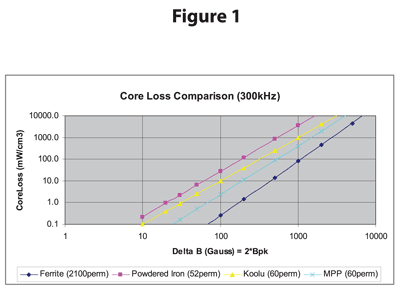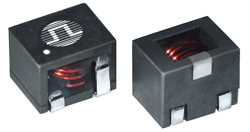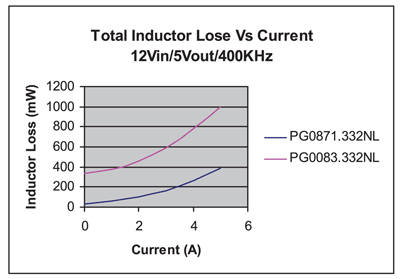New ferrite core round wire coil inductors outperform traditional iron powder core flat coil inductors in datacom applications
BY GERARD HEALY
Pulse, Tuam, Ireland
http://www.pulseeng.com
Iron powder (IP) core flat coil inductors have become the default choice of design engineers that need to meet low inductance (0.4 to 10 µH) requirements at high currents (10 to 40 A). However, these inductors are commonly designed into applications which do not require the very low profile offered by the flat coil winding inductors at a price premium. Flat coil inductors at a price premium were originally developed for mobile computing applications, and feature different critical requirements than that of datacom applications.
The IP flat coil inductor’s characteristics do not yield an optimum inductor design for the modern high- frequency switch-mode power supply (SMPS). An alternative winding technology and material choice is presented to reduce costs and increase performance while using the additional available height. Finally, a direct comparison between the IP flat coil and the new inductor validates this performance enhancement in a real application.
The optimized inductor
The optimum inductor design is best derived by considering the features, benefits and limitations of the present IP flat coil solution. This solution is constructed from a helical coil wound from rectangular cross section wire, which provides an excellent core fill factor, and is surrounded by IP material.
With the low inductance achieved by a few turns, the winding has low dc resistance (Rdc ) in a very low profile. In applications where this is not a requirement, the same Rdc per turn can be achieved in a coil using standard round wire of the same cross section. The height of the round wire coil (RWC) is increased, but with the immediate benefit that is a much reduced coil cost.
The IP material can support large currents without saturation. The saturation current is significantly higher than the rated heating current, which is an advantage for computing applications where the power supply needs to provide high currents for a short duration. However, in datacom SMPS applications, this feature is not useful, as the peak (or ripple) current is a fixed percentage of the rms current. A better solution is one where the saturation current is just a little larger than the heating current
The IP material also has relatively high core losses. A comparison of other available magnetic materials shows that there are superior options, especially when considering that inductors in datacom applications typically have higher volt-second drops, which generate a larger core excitation when compared to the low voltage drops in computing applications. The increased excitation (Delta B) generates significantly higher core losses, particular at higher switching frequencies (see Fig. 1 ).

Fig. 1. Core loss vs. Delta B for different core materials.
Finally, the IP material has an inherent tendency to degraded when continuously subjected to elevated temperatures in excess of 100C over a long period of time. While this is not a concern for mobile computing applications, thermal aging is an issue for applications where components are required to have an operating temperature range up to 125C. Higher-grade IP materials are available, but this further increases the cost of the component.
In comparison, ferrite material does not have issues with thermal aging, is low in cost and offers 10% of the core losses of IP material. Significant performance enhancement arises from selecting this material.
The ferrite round wire coil inductor
The optimization process is incorporated into the ferrite round wire coil inductor demonstrated in Fig. 2 .

Fig. 2. The ferrite round wire coil inductor.
Some additional features include:
• Flattening and self terminating of the coil ends for increased reliability
• Dummy third pin for increased mechanical stability.
• Less turns compared to IP equivalent, lower Rdc .
• Tighter Rdc tolerance.
• Optimized core design based on coil dimensions further reduces core losses.
• Possible to increase number of winding turns/larger inductance range.
Performance comparison
The table in Fig. 3 shows the electrical specification of two inductors of comparable size (7.5 x 7.5 mm). The height of the RWC is 6.4 mm, while the flat coil equivalent is 3.2 mm.
The RWC features a significantly lower Rdc and the saturation current is optimized to 30% greater than the heating current. Considering a typical end application as outlined below, this and the reduced core losses significantly reduce the total inductor losses.

Fig. 3. Total inductor losses vs. current comparison for RWC and flat coil.
The development of a new type of wound inductor was motivated by the need to offer a lower-cost solution for low-inductance, high-current requirements to the datacom market compared to currently available product offerings. The RWC inductor achieves this by reducing the cost of the winding technology. The selection of a ferrite core material brings the additional benefit of improved performance and an increased operating temperature range. ■
Advertisement
Learn more about Pulse Engineering





